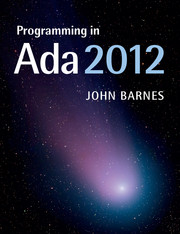21 - Object Oriented Techniques
Published online by Cambridge University Press: 05 July 2014
Summary
We have now introduced all the main features of Ada 2012 and illustrated them with many examples. An important topic which has arisen in various forms is object oriented programming. Chapter 14 introduced type extension and dynamic polymorphism using tagged types. Chapter 18 discussed type parameterization by discriminants. Chapter 19 covered static polymorphism through genericity. And finally Chapter 20 on tasking discussed concurrent objects which some might feel are the only true objects anyway.
However, the linear exposition has prevented us from exploring a number of important interactions between these features. Accordingly this chapter addresses a number of examples which further illustrate the various techniques and show how they fit together. The next chapter addresses further examples of tasking.
Extension and composition
We start this chapter on object oriented techniques with some general remarks about type composition.
There are a number of ways in which types can be put together. An array type is composed of two other types, the index type and the component type. A record type is composed of the several types of its components. Type extension is a special form of composition in which a record type has the same components as another type plus additional components at the same level.
As an example consider the following two declarations of the type Circle
type Circle is new Object with -- type extension
record
Radius: Float;
end record;
type Circle is -- type composition
record
Obj: Object;
Radius: Float;
end record;
Although both have three eventual components, the structure and naming are quite different. The fundamental difference is between ‘X is a Y’ and ‘X has a Y’. The circle is an object and so the type extension is the appropriate form.
It is interesting to contrast this with
type Cylinder is new Circle with
record
Height: Float;
end record;
briefly introduced in Section 14.1. This type Cylinder is foolish; a cylinder is not a circle although it does have a circle as part of its structure.
In deciding the correct approach, a good test is to check that class wide operations still apply – especially since they cannot be overridden. But clearly Distance is curious because the distance to the centre of the cylinder will depend upon whether we are thinking of the cylinder as standing on the plane or not.
- Type
- Chapter
- Information
- Programming in Ada 2012 , pp. 551 - 586Publisher: Cambridge University PressPrint publication year: 2014

